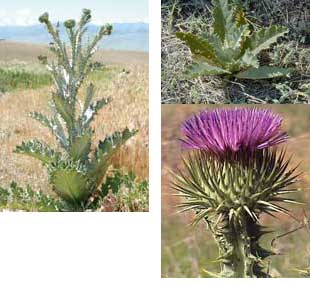Scotch Thistle
Onopordum acanthium L. and O. tauricum L.
Keys to Identification
- Up to 8 ft tall
- Large, coarsely lobed, hairy leaves have a velvety-gray appearance
- The rosette forms the first year and can have leaves up to 2 ft long and 1 ft wide
- The spiny-edged, alternate leaves form leaf wings that extend down onto the stem
- This branching plant has reddish-purple to violet flowers and a large, fleshy taproot
- It is found primarily along roadsides and railroads, but can become an impassable obstacle to livestock on rangeland and pastures. It is increasing in densities throughout Colorado
- In the Pueblo area a different species of Scotch thistle (Onopordum tauricum) is found. This species is bright green and has no hair on the plant
This information courtesy of the Colorado Natural Areas Program
Family
Sunflower (Asteraceae)
Other Names
Cotton thistle, winged thistle
USDA Code
ONAC, ONTA
Legal Status
Colorado Noxious Weed List B
Identification
Lifecycle
Perennial
Growth form
Forb
Flower
Flower heads are numerous, 1-2 in wide, with spine-tipped bracts. Flowers are violet to reddish.
Seeds/Fruit
One-seeded fruit (achene) is wrinkled, brown to grayish-black, tipped with a plume (pappus) of slender bristles (Stubbendieck et al. 1995).
Leaves
Leaves are alternate, large, irregularly lobed, and have sharp yellow spikes. Rosette leaves may be up to 2 ft long and 1 ft wide (Whitson et al. 1996). Upper and lower leaf surfaces are covered with a thick mat of cotton-like or woolly hairs, giving the foliage a gray-green color (Dewey 1991).
Stems
Mature plants can grow up to 12 ft tall. Stems are numerous, branched, and have broad spiny wings.
Roots
Thick fleshy taproot.
Seedling
Forms rosette.
Similar Species
Exotics
Onopordum acanthium is the predominant Scotch thistle species in the western United States and is characterized by its hairy leaves (Beck 1991). A hairless species, Onopordum tauricum, also occurs but much less frequently, mostly in the Arkansas River drainage in Colorado (Beck 1991).
Natives
There are many native thistle species (in the genus Cirsium). The natives generally do not have leaves clasping the stem all the way from node to node (strongly decurrent leaves), and many have hairy upper and lower leaf surfaces and are blue-green or gray in color.
Impacts
Agricultural
Scotch thistle is an aggressive plant that is competitive with desirable native forage species. It can form dense stands that are impenetrable to livestock.
Habitat and Distribution
General requirements
Scotch thistle is often found along roadsides, irrigation ditches, waste areas and on rangelands. It is especially fond of areas that are adjacent to riparian or sub-irrigated deeper soils along stream courses, lower alluvial slopes and bottomlands.
Distribution
Occurs sparsely over much of the United States. It is increasing in densities throughout Colorado.
Historical
Native to Eurasia.
Biology/Ecology
Life cycle
Scotch thistle is a biennial that produces a large, ground level rosette the first year, and a tall, spiny plant the second. Flowering occurs from mid-June to September.
Mode of reproduction
Seed.
Seed production
One plant produces 70-100 flowering heads containing 100-140 seeds per head (Young and Evans 1969).
Seed bank
Seeds may remain viable in the soil for over 30 years.
Dispersal
Plumed seeds can be dispersed by attaching to clothing and animal fur. Seeds may be transported in hay and machinery, and seeds may be carried by wind and water.
References
Beck, G. K. 1999. Biennial thistles. In: R.L. Sheley and J.K. Petroff (eds.) Biology and management of noxious rangeland weeds. Oregon State University Press, Corvallis. pp. 145-161.
Beck, G.K. L.F. James (Ed.). 1991. Biennial thistle control with herbicides. Noxious Range Weeds. Boulder: Westview Press. pp.254-259.
Dewey, S.A. L.F. James (Ed.). 1991. Weedy thistle of the western United States. Noxious Range Weeds. Boulder: Westview Press. pp.247-253.
Stubbendieck, J., G.Y. Friisoe and M.R. Bolick. 1995. Scotch thistle. Weeds of Nebraska and the Great Plains. Nebraska Department of Agriculture, Bureau of Plant Industry, Lincoln, Nebraska. pg. 169.
Whitson, T.D.(ed.), L.C. Burrill, S.A. Dewey, D.W. Cudney, B.E. Nelson, R.D. Lee, R. Parker. 1996. Scotch thistle. Weeds of the West.
Western Society of Weed Science, in cooperation with the Western United States Land Grant Universities Cooperative Extension Services, Newark CA. pg. 164.
Young, J. A. and R. A. Evans. 1969. Germination and persistence of achenes of Scotch thistle. Weed Science 20: 98-101.

